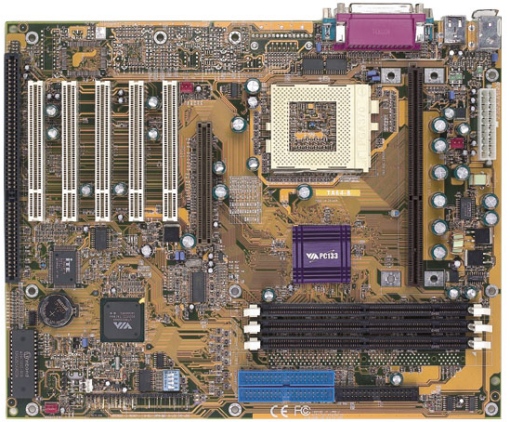DFI
TA64B VIA Apollo 133A Motherboard Review
DFI has been quite a well known motherboard
manufacturer and this fame can directly be attributed for their very
attractively priced products. They offer a wide range of motherboards which are
set not to pinch your pockets too hard. And as with all the others out there,
DFI does have a VIA Apollo Pro 133A chipset based solution as well… their DFI
TA64B.
Unlike most, DFI chose to design the TA64B as a twin socket
interface. It is equipped with both a Slot 1 and a Socket 370 processor
interface. What this means is that one can easily make use of current Intel CPU's
without having to utilize a "slocket" adapter.
So how does this make of
motherboard fare against other Apollo Pro 133A boards out there? Read on to find
out more...
Features and Specifications
Socket 370/Slot 1
ATX Motherboard, supports all available Intel PPGA, FCPGA, Slot 1 processors
& the Cyrix MIII
Based on the VIA Apollo Pro 133A (694X) Chipset,
officially supports 66/100/133 MHz FSB
Three 168 pin SDRAM DIMM sockets
support up to 1.5GB, support for PC 100/PC 133 SDRAM or VCM (virtual channel
memory), supports ECC (Error Checking Correction)
1 AGP (up to 4X mode) 5
PCI slots (all V2.2 compliant, one shared), a 16 bit ISA slot, No AMR slot
Supports the following bus settings through BIOS: 66, 75, 83, 100, 103, 105,
110, 112, 115, 120, 124,133
1 FDD port, 2 ATA/66 IDE channels
Award
6.00 PCI BIOS with green, ACPI, APM, PnP, DMI, functions and Year 2000
compliant, Suspend to RAM, Power failure resume
Built in chipset hardware
monitoring functions (ITE IT8693F A) On board voltage monitors for CPU Vcore,
3.3V,5V, 12V, CPU/Chassis/AGP fan speed monitor, CPU/System temperature
monitoring and alarm for all the above
2 serial ports, 1 parallel port, 2
USB ports, IrDA port, PS/2 Mini DIN mouse & keyboard ports

First Impressions
The package of the
TA64B contained the following material...
The board itself
A small
manual
One ATA 66 cable & one floppy cable
One CD with motherboard
drivers, including a full version of the manual in PDF format and a system
monitoring utility.
What first caught my eye was the size of the TA64B.
As it is equipped with two CPU interfaces, it is quite natural to expect the
motherboard to occupy a bit more in terms of cabinet real estate. However, you
should not experience any problems in physical installation. Users with
relatively smaller sized cabinets may experience other issues due to the board's
size, but more on that in a bit.
The board was equipped with 1 AGP slot,
4 PCI slots and 1 PCI/ISA slot (shared). To my delight, and for the cause of
added stability, there are 14 1200µF, 14 1000µF and 2 470µF capacitors present
which is probably among the highest we will ever see in a board based upon this
particular chipset and platform. The sample received for testing did not have a
chipset heatsink attached as this piece is a very early version. However, retail
pieces do have a pretty little deep lavender coloured heatsink attached with
thermal paste. Even without the presence of a heatsink, no heat related problems
emerged during testing.
The layout of the board is perhaps the best I
have ever seen in a VIA Apollo Pro 133A board so far. All connectors/sockets are
very well positioned. DFI has done a marvelous job with the design of this
board. All the connectors are easily accessible and with no practical problem at
all. The floppy drive and the IDE headers are positioned behind the DIMM sockets
and hence, memory can be installed or uninstalled without having to remove the
AGP video card. It is possible to install full sized cards on all of the PCI
slots and the ISA slot without hindrance. The only problem I could find was
that due to the rather large size of the board, there is certainly a chance that
with smaller ATX cases the 3rd DIMM module will prevent users from installing
their CD ROM drives at the lower 5.25" slot.
The manual had all the
necessary info about the board but it was written in 4 languages and it was not
very well organized (every chapter was written in 4 languages, instead of
splitting the manual into 4 big parts, one for each language).

